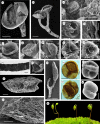The early evolution of land plants, from fossils to genomics: a commentary on Lang (1937) 'On the plant-remains from the Downtonian of England and Wales'
- PMID: 25750238
- PMCID: PMC4360123
- DOI: 10.1098/rstb.2014.0343
The early evolution of land plants, from fossils to genomics: a commentary on Lang (1937) 'On the plant-remains from the Downtonian of England and Wales'
Abstract
During the 1920s, the botanist W. H. Lang set out to collect and investigate some very unpromising fossils of uncertain affinity, which predated the known geological record of life on land. His discoveries led to a landmark publication in 1937, 'On the plant-remains from the Downtonian of England and Wales', in which he revealed a diversity of small fossil organisms of great simplicity that shed light on the nature of the earliest known land plants. These and subsequent discoveries have taken on new relevance as botanists seek to understand the plant genome and the early evolution of fundamental organ systems. Also, our developing knowledge of the composition of early land-based ecosystems and the interactions among their various components is contributing to our understanding of how life on land affects key Earth Systems (e.g. carbon cycle). The emerging paradigm is one of early life on land dominated by microbes, small bryophyte-like organisms and lichens. Collectively called cryptogamic covers, these are comparable with those that dominate certain ecosystems today. This commentary was written to celebrate the 350th anniversary of the journal Philosophical Transactions of the Royal Society.
Keywords: Cooksonia; Siluro-Devonian; bryophyte; cryptogamic cover; terrestrialization; tracheophyte.
Figures




References
-
- Lang WH. 1937. On the plant-remains from the Downtonian of England and Wales. Phil. Trans. R. Soc. Lond. B 227, 245–291. (10.1098/rstb.1937.0004) - DOI
-
- Dawson JW. 1859. On fossil plants from the Devonian rocks of Canada. Q. J. Geol. Soc. Lond. 15, 477–488. (10.1144/GSL.JGS.1859.015.01-02.57) - DOI
-
- Kräusel R, Weyland H. 1930. [The flora of the German Lower Devonian]. Abh. Preussischen Geol. Landesanstalt, Neue Folge 131, 1–92. (In German.)
-
- Kidston R, Lang WH. 1921. On Old Red Sandstone plants showing structure, from the Rhynie Chert Bed, Aberdeenshire. Part IV. Restorations of the vascular cryptogams, and discussion on their bearing on the general morphology of the Pteridophyta and the origin of the organization of land-plants. Trans. R. Soc. Edinb. 52, 831–854. (10.1017/S0080456800016033) - DOI
Publication types
MeSH terms
LinkOut - more resources
Full Text Sources
Other Literature Sources
